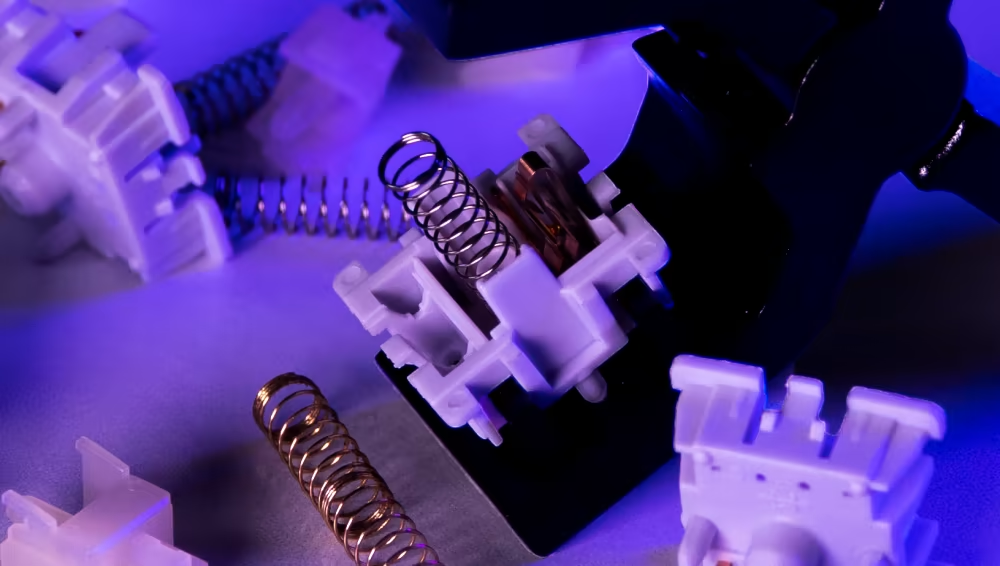Lubing Mechanical Keyboard Switches Mechanical keyboard fanatics know that lubing switches gives keyboards a smoother feel. They also know that applying lubricants to switches can reduce background noise. Proper lubing lets switches gloss over imperfections, making for a more responsive keyboard. Since most manufacturers do not pre-lube switches, it's only a matter of time before you'll need to do it yourself. Lubing switches does take time, and the process may seem overwhelming. There are a lot of switches on a mechanical keyboard! However, our guide to lubing your mechanical keyboard switches breaks down the process into seven steps, making it easy to lube switches yourself. In addition to the following tools, you will need a clear workspace that can hold keycaps and switch parts. With tools in hand, you need to pick the switch lube for your project. Picking a switch lube depends on the viscosity of the lubricant. Viscosity is how free-flowing a substance is. For example, water has a low viscosity because it pours quickly. Molasses has a higher viscosity because it pours much slower. For a lubricant to work on switches, it needs enough viscosity to remain on the switch parts. Various Switch Lubricants The viscosity varies based on the switch type. Clicky switches are designed to make noise. Be careful when lubing, so the switch does not lose its click. Knowing the parts of a switch makes it easier to put them back together. By understanding what each part does, it's simple to reassemble a switch. If you need help, it's easier to explain your difficulty. Penguin Tactile Switch Parts Before starting the process, make sure you have the tools and lubricants needed. If possible, have a large enough space to set the keycaps down rather than stack them. You will also need a space to set the switch parts. Kailh Keycap Puller Using a keycap puller remove the keycaps from the keyboard, keeping them in order. You may want to take a picture of the keyboard before you begin for reference. Gateron Switch Puller Use a switch puller to lift the switch from the keyboard. Gateron Switch Opener Switch openers make taking a switch apart much faster once you get the hang of it. Repeat the process until all switches have been dismantled. Switch Spring Rather than lubricate each spring coil, you can use a batch method if you are doing a large number of coils. This method of bag lubing with Krytox 105 oil works for many springs, but if you are lubing a few springs, you can use the following method to lubricate a single spring coil. You can add a touch of lube to the middle portion if you feel it is needed. You can use a thick lubricant such as Krytox 205g0 for this purpose. Lubing Switch Bottom Housing With a switch lube brush, dip the tip into the lubricant, making sure to remove the excess. Consider a lube palette as a way to spread the lube evenly. No white residue should be visible around the edges. Lubricating the leaves is not recommended. Husky Linear Top Housing As with the bottom housing, consider a lube palette for distributing the lube evenly on your brush. Some experts believe you only need to lube where the stem contacts the upper housing and not the legs. Lubed Gateron Yellow Stem You can lube the legs; however, it may lessen the bump of a tactile switch. After lubing all the parts, you're ready to reassemble the switches and keyboard. As you put the switches back together, be sure to look for any excess lubricant which can interfere with the contacts when reinstalled. Putting a switch back together is reversing the process of taking it apart. Reassembling Hippo Switch You should be able to depress the stem if the switch is reassembled correctly. If not, reassemble the switch making sure the parts are properly aligned. Then, return the switch to the correct location on the keyboard. Place the keycap on top of the housing. Now you are ready to test your keyboards. Once your keyboard is back together, load your favorite key tester software to make sure everything is working as intended. If keys are unresponsive or they lack that tactile bump, you've probably applied too much lube. Check the lube on the stem legs and contacts if the keys are not as tactile as before. For unresponsive keys, check for excess lube on the specific switches. Via Configurator If the keyboard feels rough or scratching, you may have missed an area when lubing. You'll need to re-open the switch. Then, re-apply the lube, making sure to touch the stem and spring. If your keyboard fails to register a keypress, you have several options: Although rare, a lubed switch may be faulty and need to be replaced. With the right tools and guidance, you can lube your mechanical keyboard switches in no time. The range of tools offered by Kinetic Labs includes magnifying glasses for less eye strain and containers for separating linear switches from tactile. Not only will you have a better functioning keyboard, but you will have the satisfaction of a job well done. Magnifying Glasses To learn more about our ear-soothing switches, eye-popping keycaps, or jaw-dropping desk mats, get in touch with us. We're always happy to answer any questions! Organic Light Emitting Diode,Pm Oled,Oled For Medical Products,Stepper Motor Oled ESEN Optoelectronics Technology Co., Ltd, , https://www.esenlcd.comTools for Lubing Mechanical Switches
Switch Lubes
Switch Parts
How to Lube Your Switches
1. Remove Keycaps
2. Remove the Switches
3. Disassemble the Switch
4. Lube the Spring Coils
5. Lube the Bottom Housing
6. Lube the Upper Housing
7. Lube the Stem
How to Reassemble a Switch
How to Test Your Keyboard
Lubing Your Mechanical Keyboard Switches
FAQs












